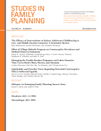Stakeholder and Provider Views Regarding Pericoital Contraceptive Pills in India and Uganda
Abstract
The development of pericoital contraceptive pills is under consideration to address unmet need for family planning, especially among women who have infrequent sexual intercourse. Pericoital pills, an oral contraceptive taken 24 hours before or after intercourse, would be a potentially desirable contraceptive option because it could provide convenience, discretion, and female control over contraceptive use. To gauge receptivity to pericoital contraception, a total of 49 in-depth interviews and 5 focus group discussions were conducted in India and Uganda with family planning providers and stakeholders. In India, the method was seen as filling a demonstrated need, based on perceived widespread and/or repeat use of emergency contraceptives. In Uganda, where emergency contraception has met strong opposition from conservative and religious leaders, respondents were more skeptical about the merits of the product. In both settings, using condoms consistently and taking oral contraceptives daily present challenges for consistent use, thus a new contraceptive method that is easy to use and under female control is likely to be appealing.




